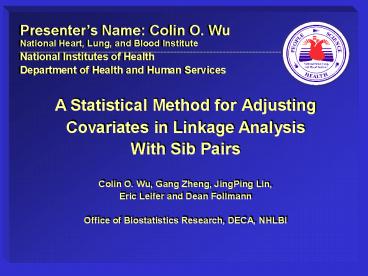A Statistical Method for Adjusting - PowerPoint PPT Presentation
1 / 32
Title:
A Statistical Method for Adjusting
Description:
Office of Biostatistics Research, DECA, NHLBI. Presenter's Name: Colin O. Wu. National Heart, Lung, and Blood Institute. National Institutes of Health ... – PowerPoint PPT presentation
Number of Views:64
Avg rating:3.0/5.0
Title: A Statistical Method for Adjusting
1
Presenters Name Colin O. Wu National Heart,
Lung, and Blood Institute National Institutes of
Health Department of Health and Human Services
A Statistical Method for Adjusting Covariates in
Linkage Analysis With Sib Pairs Colin O. Wu,
Gang Zheng, JingPing Lin, Eric Leifer and Dean
Follmann Office of Biostatistics Research, DECA,
NHLBI
2
1. Framingham Heart Study (GAW13)
- 1.1 First Generation
- 5209 subjects (2336 men 2873 women)
- 29 to 62 years old when recruited
- 1644 spouse pairs
- Continuously examined every 2 years since 1948
medical history physical exams
laboratory tests.
3
- 1.2 Second Generation (full dataset)
- 5124 of the original participants adult children
spouses of these adult children - 2616 subjects are offspring of original spouse
pairs - 34 are stepchildren
- 898 offspring are children with only one parent
in the study - 1576 are spouses of the offspring
- Offspring cohort followed every 4 years
- Interval between Exams 12 is 8 years.
4
- 1.3 Second Generation (sib-pair subset)
- 482 multi-sib families from 330 pedigrees
- Observed trait systolic blood pressure
- Covariates 1. age (in years), 2. gender
(0female, 1male), 3. drinking (average
daily alcohol consumption in ml). - Genotype data 398 random markers with an
average of 10cM apart.
5
2. Methods for Linkage Analysis
- 2.1 Methods based on identity by descent (IBD)
- Association in pedigrees between phenotype and
IBD sharing at loci linked to trait loci - Linkage for qualitative traits IBD sharing
conditional on phenotypes e.g. affected
sib-pair methods (Hauser Boehnke,
1998). - Linkage for quantitative trait loci (QTL)
phenotypes conditional on IBD sharing, e.g.
Haseman Elston (1972), Amos (1994)
extremely discordant sib-pairs, e.g. Risch
Zhang (1995, 1996).
6
- 2.2 The Haseman-Elston method
7
- HE Model without Covariate Adjustment
8
- Linkage
- Limitations
- Covariate effects are not included.
- Genetic and environmental effects are additive.
- Method may not have sufficient power.
9
- 2.3 HE Method with Linear Covariate Adjustment
(SAGE SIBPAL) - Involve families with more than 2 sibs.
- Can use other measures of trait difference e.g.
the mean-corrected cross-product. - Include covariate effects in linear regression
e.g. Elston, Buxbaum, Jacobs and Olson
(2000) Haseman and Elston Revisted.
10
- Linear generalization
11
- Linkage
- Covariate effects
- Limitation
12
3. The Proposed Method
- 3.1. Modeling the covariates
13
- Cross-sectional data
14
- Regression models for covariates
15
16
- Longitudinal data
- (Repeated measurements over time)
17
- Notation
- Linear model (Verbeke Molenberghs, 2000)
18
- 3.2 Covariate adjusted linkage detection
- General Procedure
- Select a regression model for the covariates.
- Estimate the covariate adjusted trait based on
the above regression model. - Apply the linkage procedures, such as the HE
model or the variance-components model, using the
estimated adjusted trait values and genotypic
values.
19
- 3.3 Cross-sectional data
- Covariate adjusted HE model
20
- Estimation of adjusted trait values
- Data from sib pairs are correlated
- ? Existing estimation methods for independent
data can not be directly applied. - Two approaches
- Use methods for correlated data, such as GEE
treat each family as a subject, each member as a
single observation. - Resample independent observations
21
- Randomly sample one member from each family.
- Estimate the parameters and adjusted trait values
using the re-sampled data and procedures for
independent data, such as LSE, MLE, etc. - Repeat the previous steps many times and compute
the estimates using the average of the estimates
from the re-sampled data. - This leads to consistent estimates when the
sample size (number of families) is large
(Hoffman et al., 2001).
22
- Procedure for linear adjustment model
23
- 3.5 Longitudinal data
24
- Two sources of potential correlations in the
estimation of adjusted trait values - Correlation within a sib? intra-subject
correlation. - Correlation between sibs within a family??
intra-family correlation. - ? Nested longitudinal data.
- ? Methods for longitudinal estimation can not be
directly applied (Morris, Vannucci, Brown and
Carroll, 2003, JASA).
25
- Resampling approach
- Randomly select one sib from each family?
Resampled data contain repeated measurements of
independent sibs. - Estimate the covariate adjusted trait values from
the above resampled data based on longitudinal
estimation methods (GEE, MLE, REMLE, etc.). - Repeat the above steps many times and estimate
the parameters using the averages of the
estimates from the resampled data. - Fit the HE model using existing procedure.
26
4. Framingham Heart Study
- Features of the data
- Clustered data from families
- Repeated measurements
- Multi-sib families
- Continuous and categorical covariates.
- Variables
- Quantitative trait SBP
- Covariates age, gender (0female, 1male),
drinking (average daily consumption).
27
(No Transcript)
28
(No Transcript)
29
(No Transcript)
30
(No Transcript)
31
(No Transcript)
32
5. Discussion
- Advantages for covariate adjustment
- small variation for the estimates
- better interpretation for the model.
- Directions of further research
- Non-additive models, e.g. covariate-gene and
covariate-environment interactions - Covariate adjustment with other measures of the
trait difference - Methods of model selection
- Models with general pedigrees.































